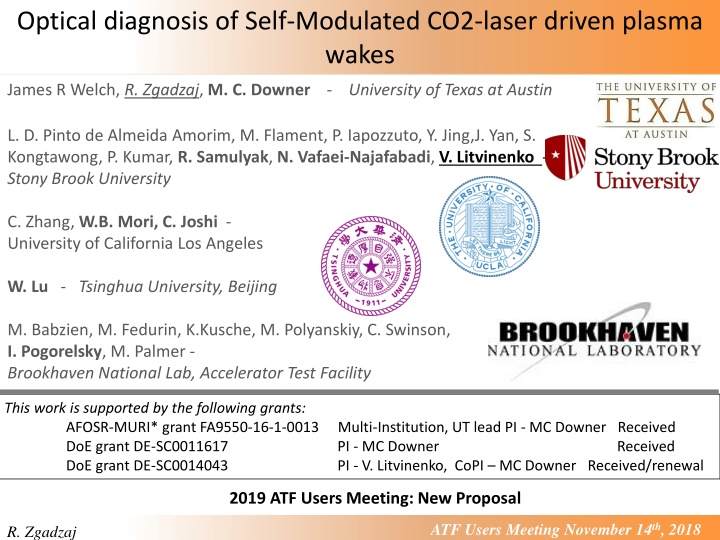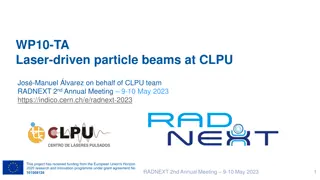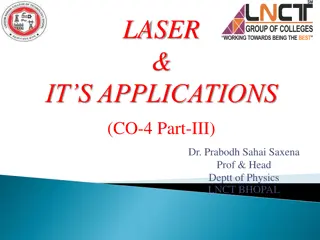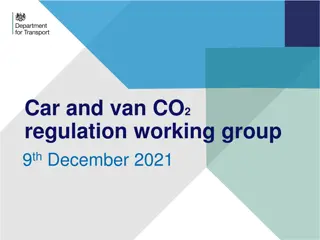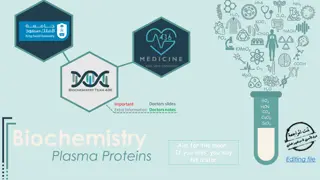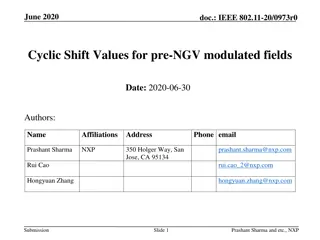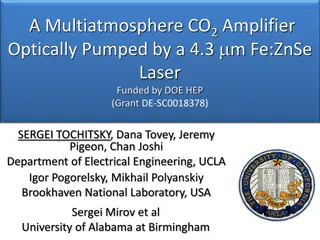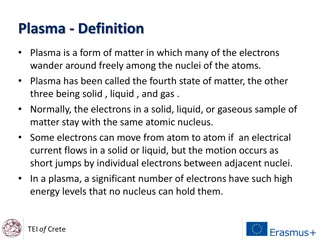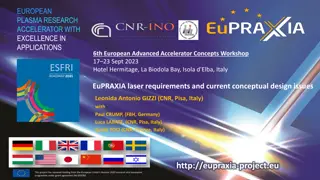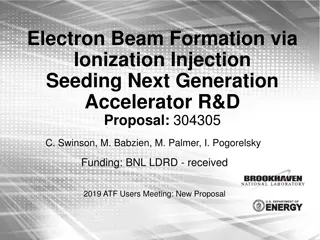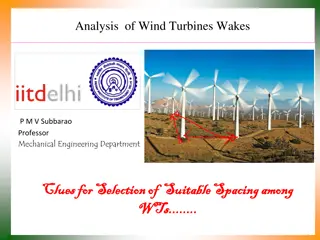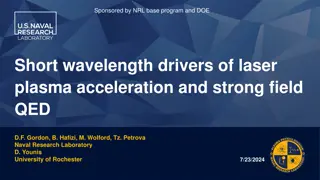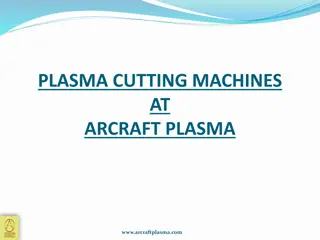Optical Diagnosis of Self-Modulated CO2 Laser-Driven Plasma Wakes
Proposed study involves experimental investigation of Self-Modulated Laser Wakefield Accelerators (SM-LWFAs) driven by upgraded CO2 laser pulses at ATF. The focus is on exploring the structure and dynamics of plasma wakes, aiming to measure accelerated electron charge, spectrum, and divergence, as well as growth and decay dynamics of wakes with low densities. Newer simulations reveal disruptions in laser pulse propagation near intensity peaks which will be visualized optically. This work expands on previous results, targeting a strongly nonlinear regime.
Download Presentation

Please find below an Image/Link to download the presentation.
The content on the website is provided AS IS for your information and personal use only. It may not be sold, licensed, or shared on other websites without obtaining consent from the author.If you encounter any issues during the download, it is possible that the publisher has removed the file from their server.
You are allowed to download the files provided on this website for personal or commercial use, subject to the condition that they are used lawfully. All files are the property of their respective owners.
The content on the website is provided AS IS for your information and personal use only. It may not be sold, licensed, or shared on other websites without obtaining consent from the author.
E N D
Presentation Transcript
Optical diagnosis of Self-Modulated CO2-laser driven plasma wakes James R Welch, R. Zgadzaj, M. C. Downer- University of Texas at Austin L. D. Pinto de Almeida Amorim, M. Flament, P. Iapozzuto, Y. Jing,J. Yan, S. Kongtawong, P. Kumar, R. Samulyak, N. Vafaei-Najafabadi, V. Litvinenko - Stony Brook University C. Zhang, W.B. Mori, C. Joshi - University of California Los Angeles W. Lu - Tsinghua University, Beijing M. Babzien, M. Fedurin, K.Kusche, M. Polyanskiy, C. Swinson, I. Pogorelsky, M. Palmer - Brookhaven National Lab, Accelerator Test Facility This work is supported by the following grants: AFOSR-MURI* grant FA9550-16-1-0013 Multi-Institution, UT lead PI - MC Downer Received DoE grant DE-SC0011617 PI - MC Downer Received DoE grant DE-SC0014043 PI - V. Litvinenko, CoPI MC Downer Received/renewal 2019 ATF Users Meeting: New Proposal ATF Users Meeting November 14th, 2018 R. Zgadzaj
SCIENTIFIC CASE Proposed study: an experimental investigation of the structure and dynamics of Self-Modulated Laser Wakefield Accelerators (SM-LWFAs) driven by ATF s recently upgraded, 2ps, 2TW CO2 laser pulses, using few ps probe pulses (various wavelengths). 2ps, 2TW, 4.8mm, w0=50 m ne ~ 4 1017cm-3 AE71 campaign - 0.5TW, 4ps CO2 laser pulses. Wakes observed, however, No detectable accelerated charge Upgraded parameters 2TW, 2ps CO2 laser pulses Simulations suggest injection and acceleration of significant charge,~nC. - New Regime of SM-LWFA Simulation: Chaojie Zhang, W. Lu Scientific interest in SM-LWFAs as copious sources of electrons for generation of X-raysaand secondary particles like Neutronsb. [a] F. Albert et al., Observation of betatron x-ray radiation in a self-modulated laser wakefield accelerator driven with picosecond laser pulses, Phys. Rev. Lett. 118, 134801 (2017). [b] I. Pomerantz et al., Ultrashort pulsed neutron source, Phys. Rev. Lett. 113, 184801 (2014). ATF Users Meeting November 14th, 2018 R. Zgadzaj
SCIENTIFIC CASE This work will expand on prior results from AE71, exploring the new strongly nonlinear SM-LWFA regime. 1) Measurement of accelerated electron charge, spectrum and divergence. 2) Measurement of growth and decay dynamics of the wakes loaded wakes decay faster. In work from the 90 s, with 1 m driver, and at higher densities, showed shorter decay rates when accelerated charge was presentc, and longer decay rates, governed by decay into ion wakes, when loading was not presentd. 3) We will push the densities lower than in AE71, to ~1017cm-3, about 100 times below the past studies. This coupled with the 10x larger drive wavelength will further affect the detailed dynamics. 4) Newer simulations by Jiayang Yan, L. D. Pinto de Almeida Amorim and Prabhat Kumar, reveal complicated disruptions of the propagating laser pulses, near the intensity peak, whose effect on the wakes will also be visualized by the optical probe. [c] S. P. Le Blanc et al., "Temporal characterization of a self-modulated laser wakefield," Phys. Rev. Lett. 77, 5381(1996). [d] A. Ting et al., "Temporal evolution of self-modulated laser wakefields measured by coherent Thomson scattering," Phys. Rev. Lett. 77, 5377 (1996). [e] D. Gordon et al., "Observation of electron energies beyond the linear dephasing limit from a laser-excited relativistic plasma wave," Phys. Rev. Lett. 80, 2133 (1998). L. D. Pinto de Almeida Amorim, SBU Jiayang Yan et al., Investigating Instabilities of Long, Intense Laser Pulses in Plasma Wakefield Accelerators, Proc. IEEE 18th Advanced Accelerator Concepts (Submitted) Workshop, 2018 [c] [e] ATF Users Meeting November 14th, 2018 R. Zgadzaj
SCIENTIFIC CASE We intend to make the following further improvements to allow the study of wake dynamics: 1) Develop CO2 laser pulse harmonic probes - Increased sensitivity at lower plasma densities. This will also allow us to capture the transverse plasma density. We may be able to extract the ion wake density radial structure, that develops several ps after the drive pulse, for example. This development will require new optics and cameras. 2) Transverse probe, combined with polarization analyzers will allow us to measure the magnetic fields present in the wakes. The copious injection, suggested by simulations, should lead to ~kT fields, readily detectable, especially at longer wavelengths. We will be able to also detect the linac pulse in this manner and use this for calibration and time delay measurements. 3) We would like to develop spectral, mode, polarization, and ideally phase diagnostics for the CO2 laser beam. These are very important as inputs for simulations. This is something that we would like to work on with other groups and ATF, since it is useful for all CO2 laser users. 4) All of these diagnostics will be working in tandem with the electron radiographic probe being developed by N. Vafaei-Najafabadi s group (previous proposal.) ATF Users Meeting November 14th, 2018 R. Zgadzaj
EXPERIMENTAL SETUP Year 2019 Year 2020 532nm, 2-4ps probe 532nm, 2-4ps probe Radiographic imaging CCD Radiographic imaging CCD H2 jet H2 jet e- beam e- beam YAG xtl YAG xtl magnet magnet Lanex Lanex CCD CCD CO2 pulse 2TW, 2ps CO2 pulse 2TW, 2ps CO2 and CTS Spectrum, mode CO2 and CTS Spectrum, mode, polarization and wavefront measurement 1) Combined radiography and longitudinal optical CTS probe, and transverse CTS probe Electron spectrum transverse electron 1) Combined radiography and longitudinal optical CTS probe Electron spectrum transverse electron 2) 2) ATF Users Meeting November 14th, 2018 R. Zgadzaj
EXPERIMENTAL SETUP Year 2021 Optical probing can be adapted for the collinear CO2 and e-beam geometry 532 nm, 5 m, 3.3 m, or 2.5 m probes Radiographic imaging CCD Example: H2 jet 532nm 2-4ps probe e- beam magnet YAG xtl Lanex CCD CO2 and CTS Spectrum, mode, polarization and wavefront measurement CO2 pulse, 2TW, 2ps CO2 and CTS Spectrum, mode, polarization and wavefront measurement 1) Combined radiography and longitudinal optical CTS probe, and transverse CTS probe Electron spectrum Magnetic field measurements transverse electron CO2 pulse 2TW, 2ps CO2 Harmonic xtl 2) 3) ATF Users Meeting November 14th, 2018 R. Zgadzaj
PLANS 2019: (a) Install electron spectrometer. (b) Install optics to measure CO2-pulse spectrum, mode shape, and polarization changes after driving SM-LWFA. (c) Probe SM-LWFA driven by 2 TW CO2 pulses with existing co-propagating green probe; scan ne(at t 0) down to detection limit; scan t (at selected fixed ne); coordinate with characterization of accelerated electrons and pump polarization changes. (d) Work together with N. Vafaei-Najafabadi SBU group to implement a transverse e-bunch probe, and to operate it simultaneously with co-propagating optical probe. 2020: (a) Install transverse green optical probe. (b) Probe SM-LWFA driven by 2 TW CO2 pulses transversely over a wide range of ne. (c) Coordinate with longitudinal optical probe and e-probe measurements, and with simulations. (d) Acquire and test optics for splitting off and frequency- multiplying probe pulses from the CO2 pump; acquire and test mid-IR optics and detectors. 2021: (a) Install mid-IR system for probing CO2-laser-driven wakes. (b) Probe SM-LWFA driven by 2 TW CO2 pulses with mid-IR system, including magnetic field effects. We have no restrictions due to funding deadlines or student thesis requirements. Most of the proposed work can be carried out synergistically with the e-probe project proposed by Navid Vafaei-Najafabadi making use of the time allotment requested therein. Thus we have requested relatively small additional independent time allotment. THANK YOU ATF Users Meeting November 14th, 2018 R. Zgadzaj
Electron Beam Requirements Parameter Nominal Requested Beam Energy (MeV) 50-65 Full range is ~ 15-75 MeV with highest beam quality at nominal values Bunch Charge (nC) 0.1-2.0 Bunch length & emittance vary with charge Compression Down to 100 fs (up to 1 kA peak current) A magnetic bunch compressor available to compress bunch down to ~ 100 fs. Beam quality is variable depending on charge and amount of compression required. Transverse size at IP (sigma, um) 30 ~1000 (dependent on IP position) It is possible to achieve transverse sizes below 10 um with special permanent magnet optics. Normalized Emittance (um) 1 (at 0.3 nC) Variable with bunch charge Rep. Rate (Hz) 1.5 3 Hz also available if needed Trains mode Single bunch Multi-bunch mode available. Trains of 24 or 48 ns spaced bunches. Special Equipment: Please indicate any special equipment that you expect to need, including (but not limited to) the transverse deflecting cavity, shaped bunch using mask technique, plasma capillary discharge system, bolometer/interferometer setup etc.
CO2 Laser Requirements The following options are available at the laser source. Note that the maximum power available at your experiment interaction point will depend on the laser transport method. OPTION 1 (full power, ~1 shot per minute) isotopic gas in final amplifier 2 TW max (2 ps, 4 J, single pulse) 9.25 um M^2 ~2 linear polarization OPTION 2 (regen only, 1.5 or 3 Hz) 3 GW max (2 ps, 6 mJ) 9.25 um M^2 ~1.5 linear polarization (circular available at slightly reduced power) ** Please note any specialty laser configurations here ** Interaction Point location: experimental hall beamline #1 LWFA chamber 9
2019 Experiment Time Estimates Run Hours (include setup time in hours estimate): Number of electron beam only hours: 0 Number of CO2laser hours delivered to laser experiment hall ( FEL room ): 100 Number of CO2 laser hours, + ebeam, delivered to electron beam experiment hall: 300 Overall % setup time: 25% Hazards & installation requirements: Large installation (chamber, insertion device etc ): complete or approved Laser use (other than CO2): Nd:YAG + 2nd harmonic, one or more of 2nd,3rd,4th harmonics of CO2 Cryogens: N Introducing new magnetic elements: Y, electron spectrometer in LWFA chamber Introducing new materials into the beam path: Yes, Yag crystals, mirror Any other foreseeable beam line modifications: N Please describe further where necessary 10
